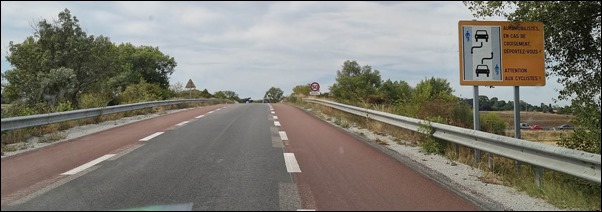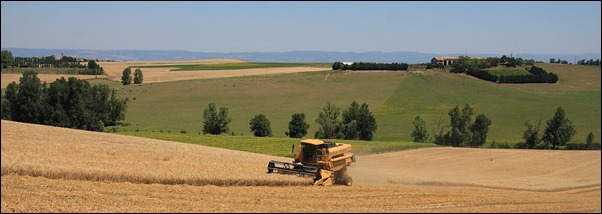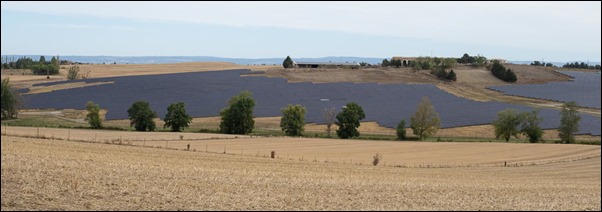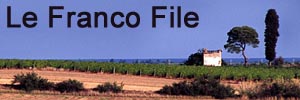‘T was a beautiful morning but we were on a mission to get on the road by 08:30 for the 485kms drive to Fanjeaux. Rosnay had been about half way not in terms of distance but in terms of driving time; all but about 40kms of today would be on autoroutes. Travelling on a Sunday is usually easier and less stressful because there are less trucks on the road. Taking breaks on a Sunday can be less easy for those towing caravans because the lay-byes, aires and services can be full of the trucks that aren’t on the road.
We bumbled along the minor roads for about 35kms out of La Brenne to the autoroute. “Beep”, went the toll tag in a reassuring fashion.
We cruised along the autoroute with a break for comfort followed two hours later for another break for comfort and fuel.
Something strange has happened to fuel prices in France. Years ago Total stations, one of the home team, were noticeably more expensive than others. Now Total is markedly cheaper than others and by quite a margin: there’s a differential of about 20c a litre for gazole [diesel]. Astonishingly, Total on the autoroutes now even seems cheaper than the opposition off the autoroutes. I have no idea why but Total stations are now certainly worth seeking out whereas I’ve been used to avoiding them.
“Beep” went the toll tag at about 15:00 as we clambered off the autoroute at Bram with just 5kms left to run. To complete the picture there had been a few other beeps around a couple of towns en route where toll roads become free to act as a bypass.
Our first shock came as we turned to drive through the tiny village of Villesiscle just after the toll booths. I was faced with an oddly painted road. Given the prevalence of sometimes reasonable cycle lanes it didn’t look terribly strange until scale was taken into account. There was a single narrow car lane in the centre of the road bordered by a sizeable cycle lane on either side. A road sign as I approached clearly wanted me to drive down the centre of the road diving to the right when faced by oncoming traffic. With luck said oncoming traffic would also dive to their right. Having passed, we would both then dive back into the middle of the road again to continue towards the next potential head-on collision. It might best be described as suicide alley; It reminded me of playing chicken.


 Complications apparently set in when cycles are actually present, which happily most of the time they aren’t. There were two different panels showing motorists how to behave in a couple of situations. One [left] had you slamming on the brakes to tuck in behind a cycle as you dived right. This one actually makes the lane look almost wide enough for two cars. The other [right] had you putting the pedal to the metal to get in front of the cycle, hopefully before slamming headlong into the opposing car, before diving to the right. This one is a much more accurate depiction of the lane width. Given the French motorists’ love of being in front [moi d’abord], it looked a bit optimistic.
Complications apparently set in when cycles are actually present, which happily most of the time they aren’t. There were two different panels showing motorists how to behave in a couple of situations. One [left] had you slamming on the brakes to tuck in behind a cycle as you dived right. This one actually makes the lane look almost wide enough for two cars. The other [right] had you putting the pedal to the metal to get in front of the cycle, hopefully before slamming headlong into the opposing car, before diving to the right. This one is a much more accurate depiction of the lane width. Given the French motorists’ love of being in front [moi d’abord], it looked a bit optimistic.
We managed to avoid either head-on collisions or flattening cyclists in Villesiscle and continued to Fanjeaux to be met by our second shock.
Our friendly dairy sheep farm is on a hill with views of the Pyrenees to the south and of the Cathar villlage of Fanjeaux to the north. Here, looking north towards Fanjeaux, is a picture I took in 2011 of son Cedric harvesting one of the fields. On the opposite hillside is a neighbouring farm. There are cattle just about visible in the far left of the facing field. It is a pleasing sight to the eye and looks quite pastoral.

What were we faced with on our arrival today as we drove in to get reacquainted with our farming friends? Acres of unsightly solar panels where once there had been cattle and grass. I’ve approximated the angle of shot and repeated it. Note that there is another massive array of solar panels to the right of this picture. The extent of the visual disaster is clear. There’s no longer any livestock and nothing remotely pastoral.

Luc and Nadine were out, this being a Sunday, but Luc’s parents and son greeted us and sent us down to le camping to get installed. We found a lovely lakeside pitch with some level ground so broke with our tradition of pitching lengthwise – it’s much easier to adjust level front to back than side to side – and pitched Guillaume sideways across the pitch with the awning facing the lake.
The awning was an interesting puzzle. It’s a design that we are familiar with having had the same before but a size smaller; current Guillaume is a little shorter than previous Guillaume. The smaller size clearly comes with the same length poles, though, since they needed to be on their shortest adjustment to fit, which gave us fun finagling them into position. We got it done, though. Second time may prove easier, if we can remember.
Luc and Nadine arrived later to share a glass of vino and say hello. They are, of course, less than complimentary about the field of solar panels ruining their view and were particularly unhappy with the noise made by the pile driver used to install the damn things. Given the extent of the installation, I can’t imagine how long it took.
Just how many ways are there for your neighbours to screw you? [Yes, I know: countless.]





















Recent Comments